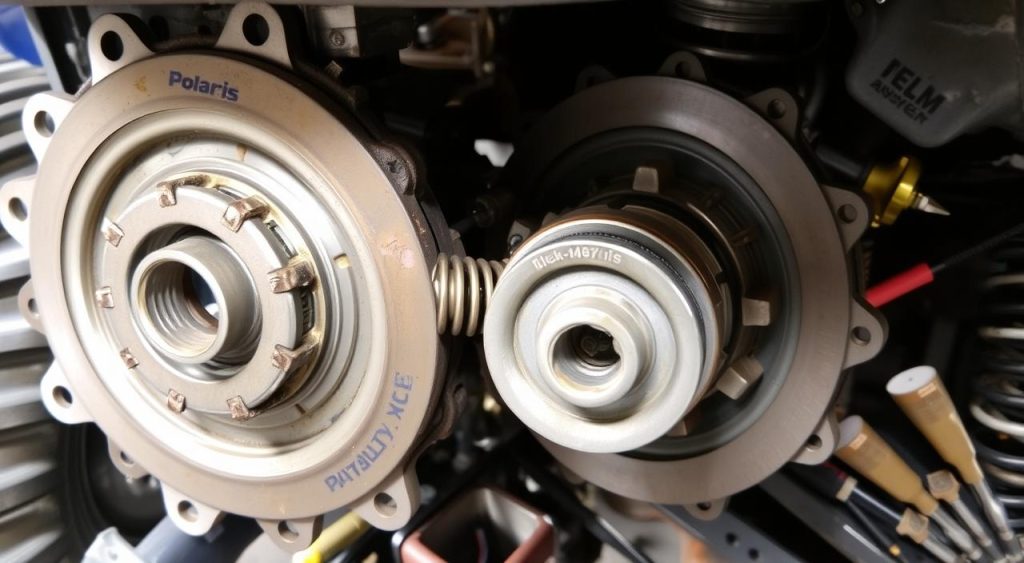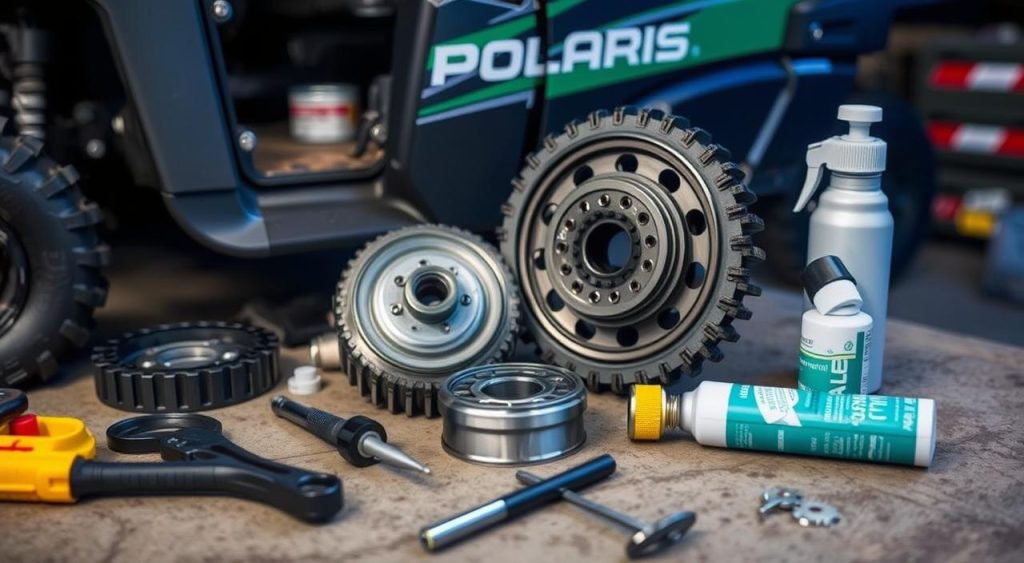One in five Polaris Ranger owners face clutch problems in their first year. This can lead to expensive repairs and lost time. As a Polaris Ranger owner, knowing common clutch issues is key. I’ll show you how to spot and solve these problems, keeping your vehicle in top shape.

Key Takeaways
- Understanding the Polaris Ranger clutch system is crucial for identifying and fixing polaris clutch issues.
- Regular maintenance can help prevent polaris ranger clutch problems and reduce the need for costly repairs.
- Learning how to troubleshoot and fix common clutch issues can save you time and money.
- Proper riding habits and environmental considerations can also impact the health and performance of your Polaris Ranger’s clutch.
- By following the steps outlined in this article, you’ll be able to diagnose and repair polaris ranger clutch problems with confidence.
- Stay ahead of potential issues with your Polaris Ranger’s clutch by following a regular maintenance schedule and being mindful of performance issues.
- With the right knowledge and tools, you can extend the life of your Polaris Ranger’s clutch and keep your vehicle running smoothly.
Understanding Your Polaris Ranger Clutch System
If you own a Polaris Ranger, knowing the clutch system is key. It’s a vital part of your vehicle’s transmission. Understanding it helps spot issues early and fix them before they get worse. Knowing about polaris ranger clutch repair is essential.
We’ll look at the main and secondary clutch parts. They work together for smooth power transfer. Whether you face common polaris ranger clutch problems or need a polaris ranger clutch replacement, this info is crucial. It helps you make smart choices and get back on the trail fast.
Primary Clutch Components
- Clutch belt
- Clutch shoes
- Clutch springs
Secondary Clutch Components
- Driven clutch
- Driven clutch springs
- Driven clutch shoes
How the Clutch System Works
The clutch system transfers power from the engine to the wheels. It’s important to understand how the primary and secondary parts work together. This knowledge helps you find and fix problems, including polaris ranger clutch replacement. It keeps your vehicle running well.
Common Polaris Ranger Clutch Problems You Should Know
As a Polaris Ranger owner, I’ve faced my share of clutch troubles. A common issue is polaris ranger clutch slipping. This can happen if the clutch belts wear out or if the components aren’t aligned right. To fix polaris ranger clutch problems, finding the main cause and fixing it is key.
Keeping up with polaris ranger clutch maintenance helps avoid these issues. Here are some clutch problems to look out for:
- Slipping or dragging clutch
- Worn-out or damaged clutch belts
- Misaligned clutch components
Knowing these common problems helps you prevent and fix polaris ranger clutch issues early. Always follow the maker’s polaris ranger clutch maintenance advice for a smooth ride.
Keep your clutch in good shape for a smoother ride and less repair costs later.
Signs Your Ranger’s Clutch Is Failing
As a Polaris Ranger owner, knowing the signs of a failing clutch is key. Polaris ranger clutch problems can be a hassle and expensive if not fixed fast. We’ll look at common signs like unusual noises, performance issues, and visual clues.
Spotting polaris clutch issues early is vital. You can do this by ranger clutch troubleshooting. This means checking the clutch system, looking for worn parts, and testing how it works.
Unusual Noises and Vibrations
Grinding, squealing, or clicking sounds mean your clutch might be failing. These sounds often come with vibrations you can feel through the handlebars or footpegs.
Performance Issues
Problems like slower acceleration, hesitation, or stalling are clutch failure signs. If you see these, get your clutch checked and fixed or replaced quickly.
Visual Warning Signs
Look out for worn-out clutch belts, misaligned parts, or clutch shoes that are too worn. Regular checks can catch these problems early.
Knowing these signs and acting fast can save your Polaris Ranger’s clutch. Always check your owner’s manual or get professional advice for clutch care or repairs.
| Signs of a Failing Clutch | Description |
|---|---|
| Unusual Noises | Grinding, squealing, or clicking sounds |
| Performance Issues | Decreased acceleration, hesitation, or stalling |
| Visual Warning Signs | Worn-out clutch belts, misaligned clutch components, or excessive wear on the clutch shoes |
Essential Tools for Clutch Diagnosis and Repair
For polaris ranger clutch repair, the right tools are key. Whether you’re fixing it yourself or you’re a pro, the right tools make a big difference. You’ll need special tools for polaris ranger clutch replacement to take out and put in the new parts.
Some must-have tools for clutch work include:
- Clutch puller
- Clutch alignment tool
- Multimeter
These tools help you find problems, take out and put in parts, and check the clutch system. Keeping up with polaris ranger clutch maintenance helps avoid issues and keeps your vehicle running well.
With the right tools and regular maintenance, your clutch will last longer and save you money on repairs. Always check your vehicle’s manual for the best way to fix and maintain your clutch.
Step-by-Step Clutch Inspection Process
Identifying polaris ranger clutch problems starts with a detailed inspection. As a Polaris Ranger owner, I’ve found that regular checks prevent big issues. Here, we’ll guide you through the clutch inspection steps to troubleshoot and fix polaris clutch issues.
Understanding the need for ranger clutch troubleshooting is crucial. It keeps your vehicle running well and lasts longer. By following these steps, you can spot problems early and avoid big headaches.
Visual Inspection Steps
Start by looking at the clutch parts like the belt, shoes, and springs. Look for wear or damage signs like cracks or frays. Note any problems you see, as they guide your next steps.
Belt Condition Assessment
Then, check the clutch belt’s condition. Look for cracks, frays, or wear. Also, check the belt’s tension to make sure it’s right. A bad belt can lead to polaris ranger clutch problems, so fix any issues quickly.
Clutch Alignment Check
Lastly, check if the clutch is aligned right. Misalignment can cause uneven wear and lead to failure. By following these steps, you can spot and fix polaris clutch issues before they get worse.
By following this clutch inspection process, you can find and fix ranger clutch troubleshooting problems. This keeps your Polaris Ranger running smoothly and efficiently.
| Clutch Component | Inspection Steps |
|---|---|
| Clutch Belt | Check for cracks, frays, or excessive wear |
| Clutch Shoes | Inspect for signs of wear or damage |
| Clutch Springs | Check for signs of wear or damage |
DIY Solutions for Minor Clutch Issues
As a Polaris Ranger owner, I’ve found that minor clutch problems can be annoying but not expensive. If your polaris ranger clutch slipping, there are DIY fixes you can try before calling a pro. Often, a misaligned or worn-out clutch belt is the culprit.
Try adjusting the clutch belt to the right tension. This is easy to do at home with basic tools. Also, regular polaris ranger clutch maintenance can stop small problems from getting big. This includes cleaning the clutch parts, oiling the bearings, and checking the fluid level.
Simple Steps to Fix Minor Clutch Issues
- Check the clutch belt for wear or misalignment
- Adjust the clutch belt to the proper tension
- Clean the clutch components and lubricate the clutch bearings
- Check the clutch fluid level and top it off as needed
By following these steps, you can fix polaris ranger clutch problems and ride again soon. Always check your owner’s manual for model-specific advice. If DIY repairs don’t work or you’re unsure, a professional mechanic is your best bet.

Professional Repair Options and Costs
When dealing with a polaris ranger clutch problem, getting professional help is key. A skilled mechanic can fix or replace the clutch, depending on the damage. The price will vary based on the clutch type, labor, and repair complexity.
Some common professional repair options for polaris ranger clutch replacement include:
- Clutch replacement: This involves replacing the entire clutch system with a new one.
- Clutch overhaul: This involves rebuilding the existing clutch system with new parts.
- Clutch repair: This involves repairing specific components of the clutch system.
Regular maintenance can prevent expensive repairs and keep your clutch system running smoothly. By keeping up with maintenance, you can avoid costly repairs and replacements. This saves you time and money.
Finding a reputable and experienced mechanic is crucial. They should specialize in polaris ranger clutch maintenance and repair. This ensures the job is done right and efficiently.
Preventing Future Clutch Problems
To avoid polaris ranger clutch problems and keep your vehicle running well, regular maintenance is key. It’s important to catch and fix issues early. This way, you can prevent big problems later on.
Regular Maintenance Schedule
Make sure to check the clutch fluid level and lubricate the clutch bearings regularly. Also, inspect the clutch parts often. This helps spot worn-out or damaged parts early. You can then replace them before they cause ranger clutch troubleshooting issues.
Proper Riding Habits
Good riding habits can also prevent polaris ranger clutch problems. Try to avoid extreme temperatures and over-revving. Always use the correct gear. This reduces stress on the clutch system and prevents early wear.

Environmental Considerations
Storing your Ranger in a dry, cool place helps prevent polaris clutch issues. Also, avoid extreme temperatures. This ensures your vehicle runs smoothly.
Clutch Upgrade Options for Better Performance
As a Polaris Ranger owner, I’m always looking for ways to improve my vehicle’s performance. Upgrading the clutch is a great way to do this. Clutch upgrade options can make your Ranger more responsive and efficient. It’s important to consider the costs and benefits of polaris ranger clutch repair versus polaris ranger clutch replacement.
Upgrading your clutch can include high-performance kits, springs, and bearings. These upgrades can make your clutch work better. To keep your clutch in top shape, regular polaris ranger clutch maintenance is key. This means checking and replacing worn parts, cleaning the clutch area, and ensuring it’s properly aligned.
Some popular clutch upgrade options include:
- High-performance clutch kits for better engagement and disengagement
- Clutch springs for improved pressure and performance
- Clutch bearings for less friction and more efficiency
When choosing a clutch upgrade, think about your riding style and terrain. For example, a high-performance kit might be best for rugged terrain. But if you mostly ride on flat surfaces, a spring upgrade could be enough. By picking the right upgrade and doing regular polaris ranger clutch maintenance, you can enjoy better performance and a longer-lasting clutch.
Always follow the manufacturer’s instructions when upgrading or maintaining your clutch. With the right upgrade and regular care, you can boost your Polaris Ranger’s performance.
| Clutch Upgrade Option | Benefits | Cost |
|---|---|---|
| High-performance clutch kit | Improved engagement and disengagement | $500-$700 |
| Clutch springs | Improved clutch pressure and performance | $200-$300 |
| Clutch bearings | Reduced friction and increased efficiency | $300-$500 |
When to Replace vs. Repair Your Clutch
As a Polaris Ranger owner, I’ve dealt with polaris ranger clutch problems. Choosing between replacing or repairing the clutch is tough. It’s important to think about the costs and how reliable it will be in the future. When facing polaris clutch issues, it’s key to carefully consider each option.
It’s important to compare the costs of repair and replacement. Repairing might be cheaper if the damage is small. But if the damage is big, replacing the clutch might be better in the long run. Ranger clutch troubleshooting helps find the problem and decide what to do next.
Think about how long the clutch will last and how well it will work. A good clutch can last for years, but a bad one might need fixing often. Regular ranger clutch troubleshooting helps make the right choice. This way, your Polaris Ranger will run well and efficiently.
When deciding to replace or repair your clutch, consider these points:
- How bad the damage is
- The cost of fixing it versus replacing it
- How reliable and durable the clutch will be
By looking at these factors and thinking about your options, you can choose the best for your Polaris Ranger. This ensures it keeps running smoothly and efficiently.
Conclusion: Taking Control of Your Ranger’s Clutch Health
Maintaining your Polaris Ranger’s clutch is key for good performance and a smooth ride. Knowing common problems and staying on top of maintenance helps a lot. This way, you can make sure your Ranger’s clutch lasts longer.
Regular checks, belt tweaks, and cleaning can prevent many issues. Also, ride smart by avoiding sudden starts and stops. This reduces stress on the clutch. If you face any problems, get help from a pro for tricky fixes.
By following this guide, you’ll keep your Polaris Ranger’s clutch in great shape. This ensures you get reliable power and enjoy off-road adventures for years.
FAQ
What are the most common Polaris Ranger clutch problems?
Common issues with the Polaris Ranger clutch include slipping and worn-out belts. Misaligned parts can also cause problems. These issues often stem from poor maintenance, old parts, or bad riding habits.
How can I diagnose a failing clutch in my Polaris Ranger?
Look out for unusual noises and vibrations. If your Ranger stalls or accelerates poorly, it might have a failing clutch. Also, check for worn belts or misaligned parts.
What tools do I need to diagnose and repair clutch problems on my Polaris Ranger?
You’ll need a clutch puller, alignment tool, and multimeter. These tools help you spot problems, remove parts, and test the clutch system.
How can I perform a thorough clutch inspection on my Polaris Ranger?
Start by visually inspecting the clutch. Check the belt’s condition and the alignment of the components. This will help you find any issues and ensure the clutch works well.
What are some DIY solutions for minor clutch issues on my Polaris Ranger?
For small problems, you can try adjusting the belt or cleaning the clutch. But, if the issue doesn’t go away or is serious, it’s wise to get professional help.
When should I consider replacing the clutch on my Polaris Ranger instead of repairing it?
Decide based on the damage’s extent, repair costs, and reliability. Compare the costs and think about the clutch’s durability and upkeep needs.
How can I prevent future clutch problems on my Polaris Ranger?
Regular maintenance and proper riding habits are key. Check the clutch fluid, lubricate bearings, and avoid extreme temperatures or over-revving.
What clutch upgrade options are available to improve the performance of my Polaris Ranger?
You can upgrade with high-performance kits, springs, and bearings. These can enhance the clutch’s performance and feel.
